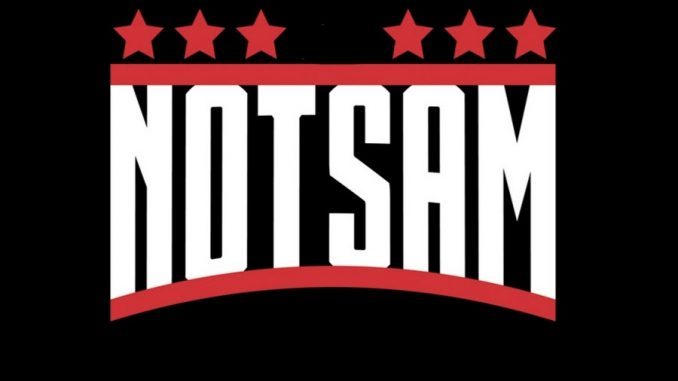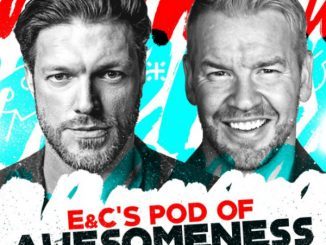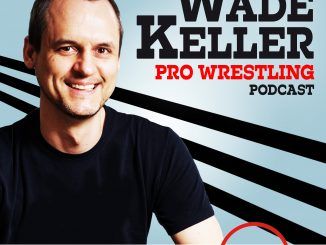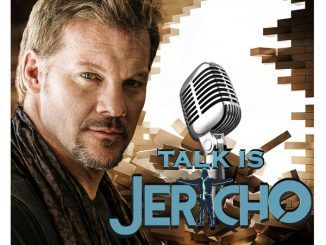
Notsam Wrestling Podcast
Episode 213: Wade Keller talks Wrestling Newsletter History, Survivor Series,
Release Date: November 22nd, 2018
Recap by: James Hayes
DIRECT LINK TO LISTEN/DOWNLOAD
From New York, Sam Roberts welcome you to the show!
Sam wishes all of us a Happy Thanksgiving!
On the show today is Wade Keller. Wade gets into several things like Vince McMahon, how he got started, his relationship with pro wrestlers, and more.
Sam discusses his issues with The Major Wrestling Figures Podcast. It’s a podcast about collecting wrestling figures. This is a rivalry that has spanned several months and shows no signs of stopping. Apparently, they called him a “mark”. What is a “mark”?
Sam wants to know and looks it up. He’s just a fan. So he does not know.
Mark is a slang term that describes a fan who believes that the characters and events of some or all of professional wrestling are real. The term can also be applied to a fan who idolizes a particular wrestler, promotion, or style of wrestling to a point some might consider excessive.
Sam says, “Would I be a mark if I was at home building an action figure arena with my podcast logo on it? Would I be a mark if I was having championship titles made so I can just walk around in them? What if I had two championships made with my logo on them just so I could walk around and say I’m the champ? Would that make me a mark? If so, well I haven’t done any of those two things. But if that would make me a mark please tell me in advance so I don’t make myself look foolish. Because I was gonna order a belt and call myself “The Internet Champion.” If that makes me a mark then I won’t do it. If it’s okay then I’ll do it. It’s all good.”
The Wade Keller Interview
On Survivor Series:
“It was originally created to kind of snuff out Jim Crocket’ts Starrcade nationally, originally as a Thanksgiving PPV. And it started as to not give anything too big away that could affect house show attendance, which is so weird. Cause that’s not their mentality now. So, we’re just going to throw a bunch of wrestlers in tag teams and package that with WrestleMania so that cable companies who have limited PPV clearances choose us instead of Jim Crockett.
It was one of the big reasons Crockett ended up selling to Turner. Because it was devastating to not get in the PPV game the way they wanted to. So, when you look at the roots of Survivor Series, the tag-team idea was not created because they thought it would be this great idea that would draw a bunch of PPV dollars. It was, ‘How can we create a PPV that will not disrupt storylines and get in the way of house show attendance and what we have a plan for other big events coming up?’
And then it went through a phase were because of that tradition it was seen as one of the big four, and then it went through a stretch where it was seen as not all that important. The elimination tag matches lost some of their novelty and luster. People knew it was Summer Slam, Rumble, WrestleMania, even King Of The Ring for a while was kind of the Summer event before MITB kind of made its mark. I think they’ve done a good job, even though there are aspects that I think are a little corny. The Raw and Smackdown rivalry which Shane McMahon completely ignored this week after saying, ‘It’s the most important thing in the world,’ last week.”
Why Survivor Series works:
“It has created a novel moment in the fall where it stands out as different. It is a chance to see a match you wouldn’t normally see otherwise. The Raw Champ vs. Smackdown. Both women and men. And then a bunch of people teaming together who wouldn’t normally team together. People wrestling each other who do not normally wrestle each other. And might not again for years.”
The Stand Out Match of Survivor Series:
“The Bryan/Lesnar match is what I think this show will be remembered for more so. In the sense that it is historically significant. It was part of this one-week evolution of Daniel Bryan’s character. It was a transformation in a big way.”
A Tough Choice:
“1987. I covered every single one of them (Survivor Series). I remember, in fact, in 1987 just a few weeks after publishing my first newsletter while I was in college. Having a choice between watching The Survivor Series on PPV, going to Oppenheim in downtown Minneapolis to watch Starrcade on close-circuit because Vince McMahon predatory move to knock Jim Crockett’s Starrcade off PPV led to Starrcade being on close-circuit instead of in a lot of places. Or go to the Minneapolis auditorium a few blocks away and watch Curt Hennig against Greg Gagne for the AWA title headline one of the last even slightly relevant AWA shows, which was a major promotion that I grew up watching. It was the birth of Hulkamania and the Road Warriors. The Warriors did not start there but they were from this area. They were very big stars in the AWA. That’s kind of where my fandom started. I ended up going to the one show I can see in person and the other I can watch later. So I went to the AWA show. It was a very big weekend for me barely a month into publishing the newsletter because there was so much to cover the weekend.”
Traveling in a Group:
“In the early ’90s there were not fan conventions but there was a group of us who traveled in the early ’90s to the WCW PPV’s in Baltimore, Philadelphia, outside of Detroit, and Phoenix for WCW PPV’s and we’d get together and coordinate, not through the internet, but through newsletters and announce there is a hotel you should get a room at and we’re just going to hang out because it was hard to find wrestling fans back then. It was pre-RSWD, pre-messageboard. It was a way through newsletters for us to meet and get to know what people look like and what they were like in person. Because we knew each other’s names, basically through letter pages in the print copy newsletters back then. So those early ’90’s conventions are really cool memories for me because it’s the only chance you had to ever get together with like-minded hardcore wrestling fans.”
Kind of like Freemasons:
“We knew people would come in the dozens. (Wade laughs.) It was almost a secret society in the sense that you would get invited by people who were already in kind of the newsletter. I won’t call it a click, but this small group of people who communicated with each other. And were hardcore fans. They might bring a fan with them who was not a newsletter reader, wasn’t that hardcore, or tell a few friends or something like that. Most of the people who showed up we felt we knew just through typing up letters and sending them in the mail to each other or reading each other’s opinions in the newsletters. It was a relatively small group, but I created new readers who are still with me today, by handing out free copies outside of Baltimore Arena. I would bring newsletters with me and stand outside of the arena grounds. I was this ambitious entrepreneur in his early twenties trying to spread the word to fans who did not know there was this source of inside information that they might have been craving and just didn’t know it existed. It was a marketing opportunity to reach new people who then later ended up becoming part of that circle of insider fans, so to speak.”
Finding Interviews:
“It was news-based. One of my early niches was interviews. Nowadays it’s unimaginable to not be able to hear wrestlers talk about the business in a conversational way. That was taboo. I mean, kayfabe, or protecting the inner workings and the way the business operated was still a big thing in the late ’80s. It was a bit of a pioneering approach to take trying to get wrestler’s to speak on the record. So, besides the news aspect of it, which was results, but it was also going to local indie shows, going to AWA shows, trying to establish contacts and getting information. Wrestlers wanted information to be spread. Not everybody. But there were wrestlers, especially the younger generation who wanted the truth to be out there about what was going on behind the scenes, especially if they felt unfair things were happening in terms of pay, scheduling, and politics. So, it was their way of getting the word out about the old guard and the new guard wanting to have an influence.”
First Big Interviews:
“Verne Gagne was very old school. I don’t think he had any idea what he was getting himself into based on at one point going, ‘Who are you, again? And who are you with?’ when I started asking questions about controversies regarding Verne Gagne. They thought I’d ask, ‘What’s your favorite match? Whose your toughest opponent?’ And early on I went against that. It was controversial when Chris Cruise was a WCW announcer, under contract at WCW did an interview with me and talked very frankly about the wrestling industry. The scene, the politics of announcing, all that stuff. He got heat for that. He was a former CNN anchor and was like, ‘I respect what you’re doing and I want to interview. Eddie Gilbert, Paul Heyman, Jim Cornette those were… Mick Foley, those are four of the really big new generation names who did long form on the record interviews with me in the late ’80s into the early ’90s. I have hours and hours of interview with Heyman, and Eddie, and Cornette, and Mick Foley. And their ideas and the way they looked at the business and the way they were willing to speak openly about, was a huge thing. So, even when I would reach out to ask someone to do an interview I would just start networking. I’d start asking people I know of for phone numbers and I would cold call wrestlers. It’s rude to think of that now. I don’t even cold call my friends.”
Wade’s Pitch:
“I would cold call wrestlers and say, ‘Hey, I’m Wade Kellar with the Pro Wrestling Torch Newsletter. Don’t know if you ever heard of me, but we do interviews. I’d love to have a half hour or hour of your time.’ And I would get interviews that way. Or they would go, ‘I don’t want to do an interview, but can I tell you something off-record?’ So, sources got created that way.”
Who Refused Wade:
“It’s funny. I had a good sense of who probably would not be receptive and probably was wise enough or steered away from calling them.”
His Strategy:
“I would do Summer Annuals. I did Year End Yearbooks. And I did Summer Annuals. Besides the newsletter every week I’d put together books, which I need to re-issue one of these days. I would do themes. So, I’d have a Summer Annual about the Evolution of wrestling, and my goal was with that, to talk to people who normally would not think of talking to a dirt sheet or a newsletter. I would get one name who was an older legend and old school to agree, then I’d use that to leverage getting more people to join. And so in the Summer Annuals, I did the Evolution of Wrestling and I’d talk to Roy Shire, Lou Thesz, Jerry Lawler. So, I’d talk to a bunch of old timers and get them to talk about… and I wanted to learn, it wasn’t just a ruthless marketing strategy. I wanted to learn, I wanted to talk to these older names. They hadn’t talked at length about the business. There wasn’t book writing. There wasn’t podcasting, so, I saw it as an opportunity to gain some insight from them, and get it imprinted on record for history. So, that was a way I approached people like Jerry Lawler, who then was very old school and would have said no, but I would say, ‘But, Jerry I got this guy, and this guy, and this guy, and I think you belong in the group with these legends. And Jerry’s like, ‘Alright.’ And then it went well. I did my homework and I approached it in a way where people were willing to talk to me.”
“I did a theme of announcing. It was a big deal, but I got Jim Ross and Lance Russell. Ken Resnick was also in that book. I interviewed Mich Karch, who was an AWA ring announcer and longtime indie wrestling announcer, I got a bunch of announcers to do an interview with me because they didn’t want to be left out of the announcer’s book because there’s so little pro wrestling media. That’s an approach that I took. And that lead, in some cases, to people who would be willing to talk to me, or point me in the right direction to talk to other people to develop sources and gather news.”
Working with WWE:
“There was a time when Sally or Ed would call me from WWE Headquarters every Monday morning and if I was in the office I’d pick up, if not they would leave a message and they would tell me the exact attendance, the exact amount of money earned from ticket sales, and the exact amount of money earned from merchandise sales with the per head average. And they wanted that on record and in print because they got tired of seeing numbers that were wildly wrong. And they were not a publicly traded company but for whatever reason, they wanted it out there, but this is the funny part if I called them up three days later and said, ‘Hey can you tell me the next time you a going to be in Chicago?’ They’d go, ‘We can’t release that information publicly.’ It was crazy! They felt like if dates got published other promoters with mess with them. So, they wanted to create a lot of footwork. It’s one of those weird quirky things, You couldn’t get anything out of WWE on an official level about anything coming up in the future. The only way you could know when a show was coming up, there were no releases through email or a website, or twitter, you had to know someone who watched television in that market who would then send you a message on your answer machine and say, ‘Wade they announced the next time they’re gonna be at the US Pavilion in Chicago.’ So, yeah they’ve been cooperative… at times.”
Drying Up Sources:
“Information sources will go away (after bad reviews) when they would have been valuable, and I still said what I said and wrote what I wrote. And it did cost me sources and scoops. I’m not trying to say it’s the most important thing in the world or like, ‘I stood above my competitors with more integrity,’ or anything like that.” But it just wasn’t in my DNA to ever get in that game.”
Vince McMahon:
“There’s been times when Vince McMahon called me up to complain about Ted Turner. Vince called me one time and demanded I do an on-record interview with him so he could vent. There have been times when I called to ask him for an interview, and I said ‘I’ll send you a list of topics I have so you can think about them, but I can’t promise these are the only questions I’ll ask.’ It was through the PR person and they said, ‘No, tell us the questions beforehand.’ I told them, ‘I cannot agree to those terms. I would never do that.’ And it didn’t happen. So, I turned down a Vince McMahon interview at one point, but years later we did one. It was great. So, yeah, it’s been various levels of friendliness and non-friendliness. ‘Hey Wade, come to WrestleMania we’ve got a media thing section set up or invites to shows and other times less friendly.”
Jim Cornette:
“Smoky Mountain Wrestling was running angles that were drawing upon racist tendencies of parts of his fanbase, with the gangstas and it lead to the N-word being thrown around by wrestlers, fan riots, six police stations were called from the region. I did a big story on it and that’s when Cornette blew up at me. He thinks I made too big of a deal about it. I interviewed people who were on the scene and fans, and really did a thorough job of it, and Bruce Mitchell, my columnist who’s been a big part of this since 1990, was very strong in his wording. It was one of those situations where it blew up a source. I agree with Jim Cornette on probably 80 percent of things politically and wrestling wise. It ended things with me and him mutually, since then. He said, ‘Don’t worry about me getting a gun through the airport because I’m just gonna drive. And I have it on tape. Cornette is a hothead and friends of his were like, ‘He might be serious. He might not.’ I was like, ‘Oh, great.”‘
If you’d like to hear more including why Wade doesn’t really have many pro wrestler friends, click the link at the top.
There is a great deal for PWTorch. You can get the VIP treatment for 50 cents for the first month if you reference Sam’s show. (It’s a good deal!)
State of Wrestling
5. Survivor Series
Sam breaks the PPV down.
He had a problem, not with the Raw sweep, but Smackdown’s lack of a reaction. Overall he enjoyed the show.
4. David Arquette
Arquette almost perished in a death match. Last week Arquette was talking about his journey back to wrestling and oddly enough the interview seems almost prophetic. Apparently, he fought Nick Gage, (who actually did time for bank robbery) and it was not a great idea.
If you must, here it is:
3. The Elite
Will there be a new promotion from Cody, Marty Scrull, and The Young Bucks? Maybe. Actually, Sam wants Adam Paige and the rest of these guys to go to WWE, but If the guys decide to create an ALLElite promotion Sam will support them. The ALLIN PPV sold Sam on what these gentlemen can do.
2. Daniel Bryan
Bryan cut a great heel promo and Sam loved it. Sam says Bryan feels like a comic book villain now. (Agreed)
1. Braun Strowman
“The Monster Among Men” is legit injured. There are bone chips floating around in his elbow. He has a four-week turnaround which means he should be able to perform at TLC.
Rating: 8.0 out of 10
Overall Observations:
This episode is a fascinating look into pre-internet wrestling journalism. Wade Kellar is an encyclopedia of wrestling history and that is displayed generously here. There is some great insight into Vince McMahon as well as other wrestling icons. It’s actually quite engaging. Wade’s journey to success is also a great tool for budding entrepreneurs. Wade presents an excellent blueprint for making your dream a reality. As always Sam delivers his matter of fact assessment of pro wrestling with pragmatism, logic, and insight. This episode flowed nicely. I enjoyed it. You will too!
About James:
Based out of New York, James Hayes is an independent filmmaker and podcaster, currently working on a true crime series focused on African American crime. When he needs a break from the seriousness of true crime he turns to pro wrestling. James has 27 years of following the sport. Here is a link to his film credits https://www.imdb.com/name/nm2026980/, as well as his Twitter @JamesHa34395813.




Be the first to comment